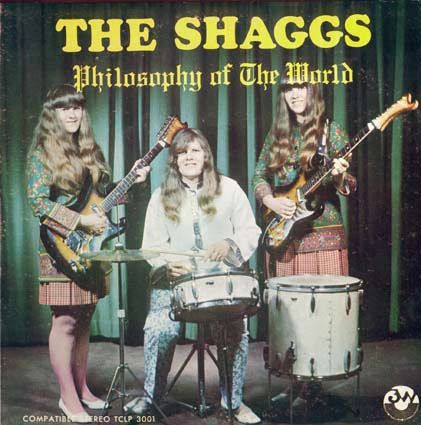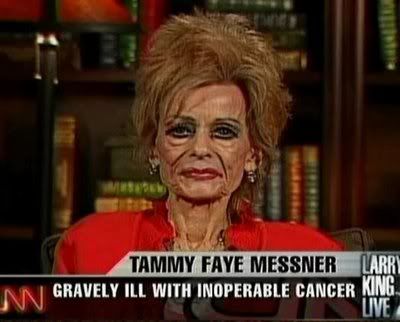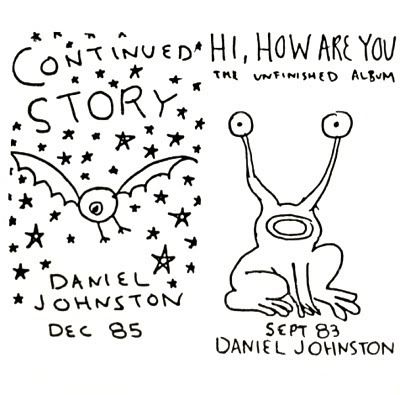Outsiders and Outcasts of the '80s
The term Outsider music or Outsider Rock was not a common term until the mid 1980s when the genre began to springboard its way into cult popularity status through the work of three particular musicians: Jandek, Daniel Johnston and Charles Manson (Yes, that Charles Manson).
In 1986, several late night radio shows in New York coordinated a "Jandek Across America" event in which nothing but Jandek was played from 1pm to 2pm on each station. Jandek, pictured above, was the unibomber of Outsider music: he was very secretive. Meanwhile, halfway across the country, Outsider poster boy Daniel Johnston (the artist that has blessed us with such wisdom as: don't play cards with the devil cuz he'll deal you a hand that's awful) had begun reaching the national consciousness as a feature character on Mtv's Cutting Edge (a 1985 profile of the Austin Texas music scene). Around this same time Charlie Manson's early recordings were faring well, partly because of several punk band's appreciation of him, but also thanks in part to a corporate-sponsored 60's Rock Renaissance that had America looking back in 1986.*
Just as compact discs were hitting their stride, Outsider-ish recordings of 60's Rock musicians like Brian Wilson, Syd Barrett, Roky Erickson, Skip Spence along with two Frank Zappa finds; Captain Beefheart and Wildman Larry Fischer (whose 1986 duet with Rosemary Clooney called "It's a hard business" became an instant Outsider anthem) were gaining notoriety. But it was The Shaggs' Philosophy of the World that really set the water mark for Outsider Rock recordings.

The Shaggs were made up of four sisters from Fremont, New Hampshire who were managed by their (some claim abusive) father, Austin Wiggen. Initially, Philosophy of the World sold less than 100 copies upon its release in 1969, but when it was name-checked by Frank Zappa in a 1976 Playboy poll, it was suddenly put on the Rock map. After that, there was so much demand for the album that it was eventually re-released, this time by Red Rooster/Rounder (in 1980 as an LP and then on CD in 1988). The LP was so well received at that time that it inspired Rolling Stone magazine to name the Shaggs as the "Comeback band of the Year" and has since been the bench mark of the unpretentiousness, the honesty, and authentic, naïve, childlike qualities that have come to define Outsider Music.
To pin down an exact definition of Outsider Music can be tricky. If you define it as music that is outside the mainstream music industry, then that could include anything from punk to polka. If you define it as music that is recorded not for popular consumption, then that too is not exactly correct, since Outsider musicians often dream (perhaps delusionally) of mainstream success. If Outsider music is defined in relation to Outsider Art, then it has to be put in the context of music that is created by folks who are mentally imbalanced (for that is what Outsider Art was originally meant to define: the artwork made by mental home patients). Jack Mudurian, whose musical repertoire was recorded in 1981 by the activities director at the Nursing Home where he was a resident, would be a classic example of this definition.
But not all Outsider musicians are mental patients. Some seem more like novelty acts, but at the same time it is also wrong to define Outsider musicians as simply novelty acts because Outsider musicians are not necessarily "in" on the joke, so to speak. The only undeniable unifying aspect of Outsider music is its genuine expression of feelings, ideas, emotions, etc., that can't be effectively expressed otherwise. Sometimes, often times even, these ideas, emotions, etc., come from the most demented reaches of the brain, which may make us wonder, "What is insanity anyway?" Is it a disconnect with reality? But then, what is reality? After all, if someone can effectively communicate something that is insane, or something from the demented reaches of the brain, in such a way that it causes others to understand it, then isn't that a sign of Sanity and not insanity? Isn't that connection a sign that these demented ideas, etc., must be grounded in reality? For otherwise, no one other than the so-called insane person would understand these ideas, emotions, etc.
 In the mid 1990's, when Kurt Cobain was seen on magazine covers wearing t-shirts designed by Daniel Johnston, Outsider music suddenly became cool. By that time, Indie Rock (or Alternative Rock if you will) had already become just another sprocket in the music industry machinery instead of the cog it had once been, and in a smaller version of that process, it wouldn't take the music industry long to manipulate Outsider music into a neatly packaged commoditized consumer niche either. One blatant example of this was when one The Shagg's song "My pal Foot Foot" (which is about a lost cat) became the inspiration—along with outsider Tangela Tricoli's "Stinky Poodle"—for the song "Smelly Cat" that was sung by a character who was portraying an outsider musician on the number rated tv sitcom of the time, Friends. To Outsider music aficionados, this act was not only very representational of how the mainstream belittles Outsider music instead of celebrating it, but it also a clear signal that corporate music industry was processing Outsider music into its fold.
In the mid 1990's, when Kurt Cobain was seen on magazine covers wearing t-shirts designed by Daniel Johnston, Outsider music suddenly became cool. By that time, Indie Rock (or Alternative Rock if you will) had already become just another sprocket in the music industry machinery instead of the cog it had once been, and in a smaller version of that process, it wouldn't take the music industry long to manipulate Outsider music into a neatly packaged commoditized consumer niche either. One blatant example of this was when one The Shagg's song "My pal Foot Foot" (which is about a lost cat) became the inspiration—along with outsider Tangela Tricoli's "Stinky Poodle"—for the song "Smelly Cat" that was sung by a character who was portraying an outsider musician on the number rated tv sitcom of the time, Friends. To Outsider music aficionados, this act was not only very representational of how the mainstream belittles Outsider music instead of celebrating it, but it also a clear signal that corporate music industry was processing Outsider music into its fold.
Two of the biggest names in Outsider music during its process of being conformed into the mainstream were Chicago native Wesley Willis (the Tiny Tim of the 90s) and B.J. Snowden, a laid-off music teacher whose 1989 demo tape (released in 1996 by the DeMilo label as Life in the USA and Canada) is considered a classic of the Outsider genre. Other than the fact that Willis and Snowden are both African-American and that both of them would have never been discovered if Cobain hadn't made Outsider music cool, Willis and Snowden seem to be exact opposites. Willis, who commonly peppers his speech with profanity, has several twitchy physical gestures that may have been the residue of child abuse he withstood from his parents. He became homeless at a young age, wandering the streets of Chicago, scrounging for loose change wherever he could find it, and is basically considered to be one sandwich short of a picnic. Snowden, on the other hand, lives peacefully with her mother and her son, has a degree in music, was under long-time employment throughout the 90s, and wouldn't utter a curse word if you pounded her big toe with an oversized hammer. Willis's music is considered Outsider Music because it seems to be created by a madman. Snowden's music, on the other hand, seems to be created by a very happy, caring, forgiving woman. The music of both artists seems to be off somehow, although neither musician notices it one bit. In Snowden's case, that is part of the charm, while in Willis's case, it is part of the humor. This dichotomy would suggest that the unifying equation in modern Outsider music, then, is simply that the music must kind of suck in terms of the technical aspect or at least be almost childlike in the fact that it appears to be unconscious or uncaring in regards to musical convention and etiquette.
Today, in the age of MySpace Rock and ProTool Cowboys, in which any pimply-faced Middle-class teenager or lovelorn office worker in America can easily have their music cast to hundreds and even thousands of listeners the world over, all at the click of a mouse, Outsider music has become more accessible than ever. However, that is causing even more of a problem in terms of defining it. Outsider music has now become a part of the Industry. MySpace pages for the Beatles or the Stones are just as accessible as the MySpace page for Joe the Drummer or Tammy Faye Bakker, and the gulf between Outsider and Insider is shrinking every day. Which means that the time has now come for the defining of Outsider music to be left to Rockists (and the Ideology of Rockism). So that, my fellow Rockists, is your assignment for the day.
©2006 Rockism 101. All Rights Reserved

Just as compact discs were hitting their stride, Outsider-ish recordings of 60's Rock musicians like Brian Wilson, Syd Barrett, Roky Erickson, Skip Spence along with two Frank Zappa finds; Captain Beefheart and Wildman Larry Fischer (whose 1986 duet with Rosemary Clooney called "It's a hard business" became an instant Outsider anthem) were gaining notoriety. But it was The Shaggs' Philosophy of the World that really set the water mark for Outsider Rock recordings.

The Shaggs were made up of four sisters from Fremont, New Hampshire who were managed by their (some claim abusive) father, Austin Wiggen. Initially, Philosophy of the World sold less than 100 copies upon its release in 1969, but when it was name-checked by Frank Zappa in a 1976 Playboy poll, it was suddenly put on the Rock map. After that, there was so much demand for the album that it was eventually re-released, this time by Red Rooster/Rounder (in 1980 as an LP and then on CD in 1988). The LP was so well received at that time that it inspired Rolling Stone magazine to name the Shaggs as the "Comeback band of the Year" and has since been the bench mark of the unpretentiousness, the honesty, and authentic, naïve, childlike qualities that have come to define Outsider Music.
To pin down an exact definition of Outsider Music can be tricky. If you define it as music that is outside the mainstream music industry, then that could include anything from punk to polka. If you define it as music that is recorded not for popular consumption, then that too is not exactly correct, since Outsider musicians often dream (perhaps delusionally) of mainstream success. If Outsider music is defined in relation to Outsider Art, then it has to be put in the context of music that is created by folks who are mentally imbalanced (for that is what Outsider Art was originally meant to define: the artwork made by mental home patients). Jack Mudurian, whose musical repertoire was recorded in 1981 by the activities director at the Nursing Home where he was a resident, would be a classic example of this definition.
But not all Outsider musicians are mental patients. Some seem more like novelty acts, but at the same time it is also wrong to define Outsider musicians as simply novelty acts because Outsider musicians are not necessarily "in" on the joke, so to speak. The only undeniable unifying aspect of Outsider music is its genuine expression of feelings, ideas, emotions, etc., that can't be effectively expressed otherwise. Sometimes, often times even, these ideas, emotions, etc., come from the most demented reaches of the brain, which may make us wonder, "What is insanity anyway?" Is it a disconnect with reality? But then, what is reality? After all, if someone can effectively communicate something that is insane, or something from the demented reaches of the brain, in such a way that it causes others to understand it, then isn't that a sign of Sanity and not insanity? Isn't that connection a sign that these demented ideas, etc., must be grounded in reality? For otherwise, no one other than the so-called insane person would understand these ideas, emotions, etc.
 In the mid 1990's, when Kurt Cobain was seen on magazine covers wearing t-shirts designed by Daniel Johnston, Outsider music suddenly became cool. By that time, Indie Rock (or Alternative Rock if you will) had already become just another sprocket in the music industry machinery instead of the cog it had once been, and in a smaller version of that process, it wouldn't take the music industry long to manipulate Outsider music into a neatly packaged commoditized consumer niche either. One blatant example of this was when one The Shagg's song "My pal Foot Foot" (which is about a lost cat) became the inspiration—along with outsider Tangela Tricoli's "Stinky Poodle"—for the song "Smelly Cat" that was sung by a character who was portraying an outsider musician on the number rated tv sitcom of the time, Friends. To Outsider music aficionados, this act was not only very representational of how the mainstream belittles Outsider music instead of celebrating it, but it also a clear signal that corporate music industry was processing Outsider music into its fold.
In the mid 1990's, when Kurt Cobain was seen on magazine covers wearing t-shirts designed by Daniel Johnston, Outsider music suddenly became cool. By that time, Indie Rock (or Alternative Rock if you will) had already become just another sprocket in the music industry machinery instead of the cog it had once been, and in a smaller version of that process, it wouldn't take the music industry long to manipulate Outsider music into a neatly packaged commoditized consumer niche either. One blatant example of this was when one The Shagg's song "My pal Foot Foot" (which is about a lost cat) became the inspiration—along with outsider Tangela Tricoli's "Stinky Poodle"—for the song "Smelly Cat" that was sung by a character who was portraying an outsider musician on the number rated tv sitcom of the time, Friends. To Outsider music aficionados, this act was not only very representational of how the mainstream belittles Outsider music instead of celebrating it, but it also a clear signal that corporate music industry was processing Outsider music into its fold.Two of the biggest names in Outsider music during its process of being conformed into the mainstream were Chicago native Wesley Willis (the Tiny Tim of the 90s) and B.J. Snowden, a laid-off music teacher whose 1989 demo tape (released in 1996 by the DeMilo label as Life in the USA and Canada) is considered a classic of the Outsider genre. Other than the fact that Willis and Snowden are both African-American and that both of them would have never been discovered if Cobain hadn't made Outsider music cool, Willis and Snowden seem to be exact opposites. Willis, who commonly peppers his speech with profanity, has several twitchy physical gestures that may have been the residue of child abuse he withstood from his parents. He became homeless at a young age, wandering the streets of Chicago, scrounging for loose change wherever he could find it, and is basically considered to be one sandwich short of a picnic. Snowden, on the other hand, lives peacefully with her mother and her son, has a degree in music, was under long-time employment throughout the 90s, and wouldn't utter a curse word if you pounded her big toe with an oversized hammer. Willis's music is considered Outsider Music because it seems to be created by a madman. Snowden's music, on the other hand, seems to be created by a very happy, caring, forgiving woman. The music of both artists seems to be off somehow, although neither musician notices it one bit. In Snowden's case, that is part of the charm, while in Willis's case, it is part of the humor. This dichotomy would suggest that the unifying equation in modern Outsider music, then, is simply that the music must kind of suck in terms of the technical aspect or at least be almost childlike in the fact that it appears to be unconscious or uncaring in regards to musical convention and etiquette.
Today, in the age of MySpace Rock and ProTool Cowboys, in which any pimply-faced Middle-class teenager or lovelorn office worker in America can easily have their music cast to hundreds and even thousands of listeners the world over, all at the click of a mouse, Outsider music has become more accessible than ever. However, that is causing even more of a problem in terms of defining it. Outsider music has now become a part of the Industry. MySpace pages for the Beatles or the Stones are just as accessible as the MySpace page for Joe the Drummer or Tammy Faye Bakker, and the gulf between Outsider and Insider is shrinking every day. Which means that the time has now come for the defining of Outsider music to be left to Rockists (and the Ideology of Rockism). So that, my fellow Rockists, is your assignment for the day.
--- hey, look - a footnote ---
 *For example Sonic Youth's "Death Valley 69" off of their 1984 Bad Moon Rising LP expresses their intrigue regarding Manson, while their co-hort Lydia Lunch had this to say about Uncle Charlie: "You could not not love Charlie...You could not not love what he stood for. Yes, it's got to come down. Yes, this was injustice. The guy's a brilliant spoken-word artist."
*For example Sonic Youth's "Death Valley 69" off of their 1984 Bad Moon Rising LP expresses their intrigue regarding Manson, while their co-hort Lydia Lunch had this to say about Uncle Charlie: "You could not not love Charlie...You could not not love what he stood for. Yes, it's got to come down. Yes, this was injustice. The guy's a brilliant spoken-word artist."
For more writing by Ed Wagemann click here: ED WAGEMANN
 *For example Sonic Youth's "Death Valley 69" off of their 1984 Bad Moon Rising LP expresses their intrigue regarding Manson, while their co-hort Lydia Lunch had this to say about Uncle Charlie: "You could not not love Charlie...You could not not love what he stood for. Yes, it's got to come down. Yes, this was injustice. The guy's a brilliant spoken-word artist."
*For example Sonic Youth's "Death Valley 69" off of their 1984 Bad Moon Rising LP expresses their intrigue regarding Manson, while their co-hort Lydia Lunch had this to say about Uncle Charlie: "You could not not love Charlie...You could not not love what he stood for. Yes, it's got to come down. Yes, this was injustice. The guy's a brilliant spoken-word artist."For more writing by Ed Wagemann click here: ED WAGEMANN
©2006 Rockism 101. All Rights Reserved





louboutin outlet
ReplyDeletechristian louboutin sale
louis vuitton bags
polo ralph lauren uk
beats headphones
longchamp le pliage
ugg classic
timberland outlet
uggs italia
jordan retro 12
2016.12.21xukaimin